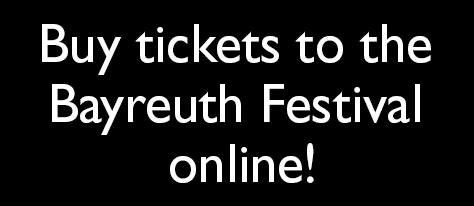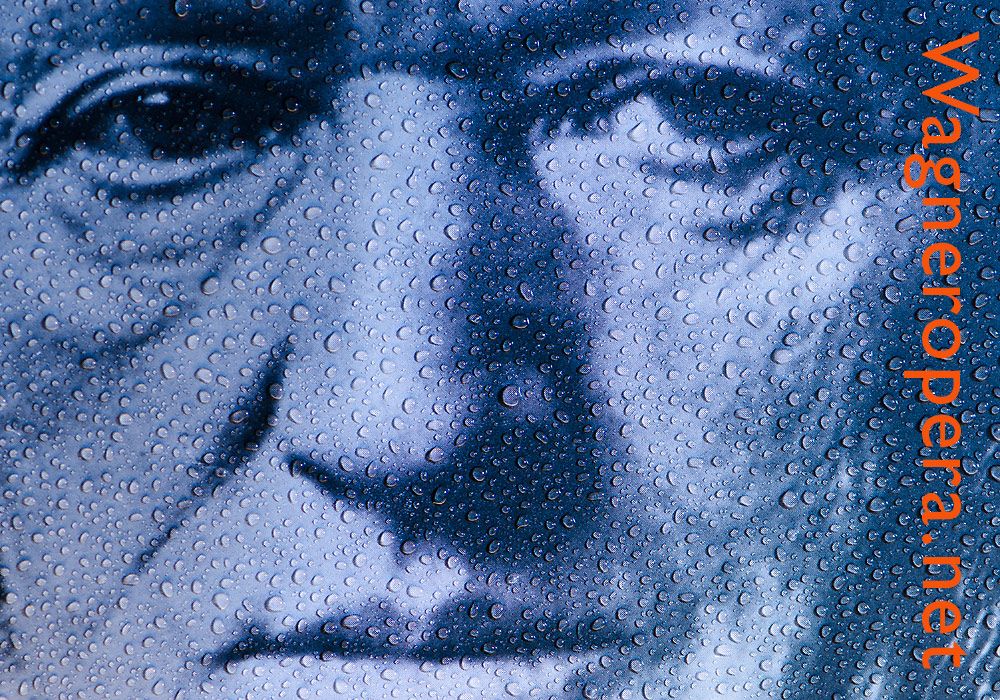Götterdämmerung - Twilight of the Gods
Götterdämmerung is the fourth and final of the operas in the tetralogy Der Ring des Nibelungen.
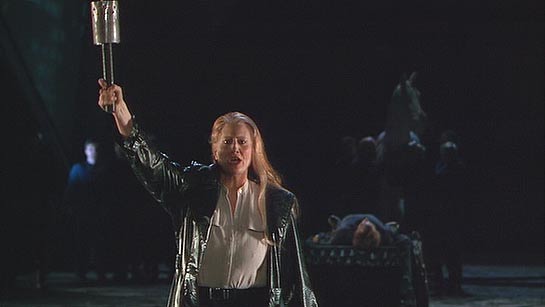
Anne Evans in Harry Kupfer's production of Götterdämmerung at Bayreuth, filmed in 1991 and available on DVD.
The premiere of Götterdämmerung was on 17 August 1876 at the Festival House in Bayreuth, as part of a complete Ring cycle. Conductor was Hans Richter.
Götterdämmerung (as part of the complete Ring des Nibelungen) was produced in the following cities the first years after the world premiere at the Bayreuth Festival on 17 August 1876
| 1878 | München |
| 1879 | Wien |
| 1880 | Hamburg |
| 1881 | Berlin (Angelo Neumann's travelling Wagner-Theatre with guest performances in Berliner Viktoria-Theater) |
| 1882–1883 | Angelo Neumann's travelling Wagner-Theatre on tour: London (Her Majesty's Theatre), Breslau, Königsberg, Danzig, Hannover, Bremen, Barmen, Dresden, Amsterdam, Brüssel, Aachen, Düsseldorf, Mainz, Darmstadt, Karlsruhe, Strassburg, Stuttgart, Basel, Venice, Bologna, Rome, Torino, Triest, Budapest, Graz – totaling 135 performances of the Ring! |
Siegfried's death and Funeral march
Klaus Tennstedt, London Philharmonic, Suntory Hall (Tokyo, Japan)
Siegfrieds Rheinfahrt / Rattle · Berliner Philharmoniker
REMASTERED: The First Commercial Recording of Wagner’s Götterdämmerung
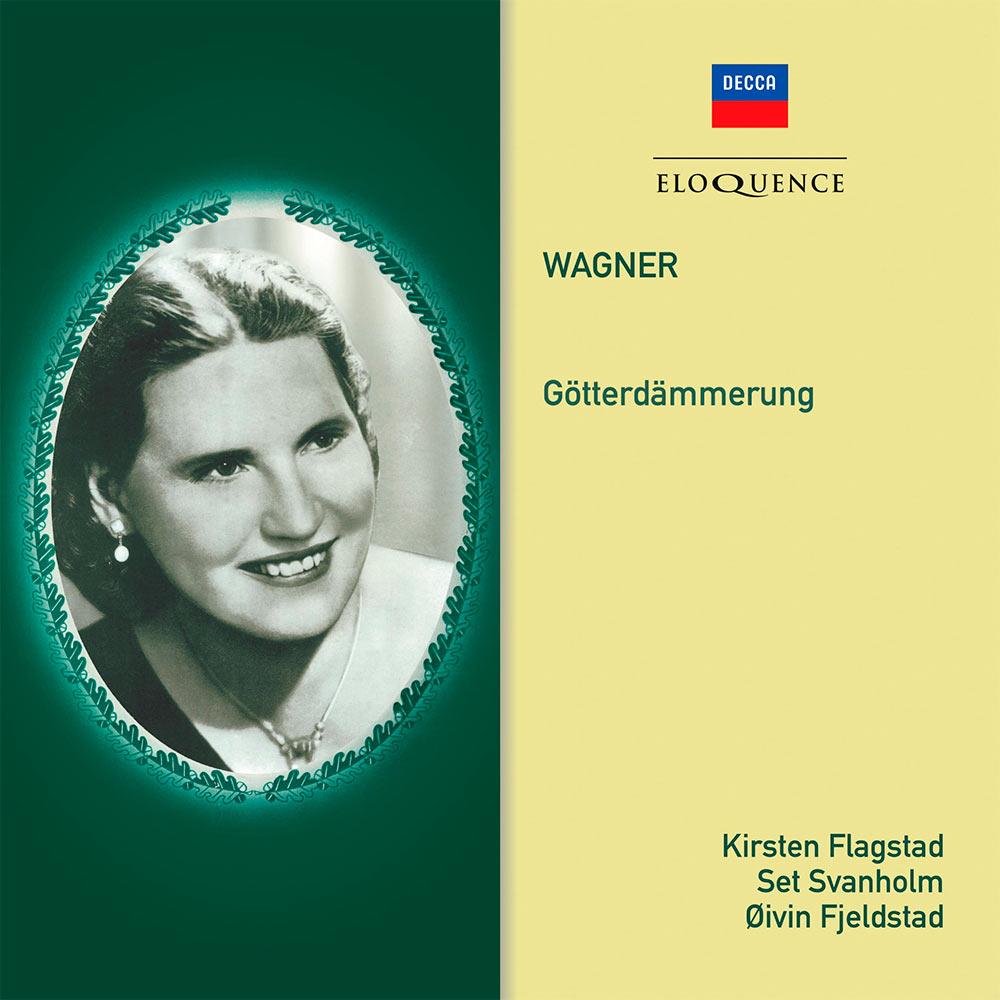
RICHARD WAGNER: Götterdämmerung: Kirsten Flagstad, Set Svanholm, Øyvin Fjeldstad (1956)
Siegfried - Set Svanholm
Gunther - Waldemar Johnsen
Alberich - Per Grönneberg
Hagen - Egil Nordsjø
Brünnhilde - Kirsten Flagstad
Gutrune · Third Norn - Ingrid Bjoner
Waltraute · First Norn - Eva Gustavson
Woglinde - Unni Bugge-Hanssen
Wellgunde · Second Norn - Karen Marie Flagstad
Flosshilde - Beate Asserson
Opera Chorus
Oslo Philharmonic Orchestra
Norwegian State Radio Orchestra
Øivin Fjeldstad
FIRST CD RELEASE ON DECCA. REMASTERED FROM THE ORIGINAL TAPES.
First commercial recording of Wagner’s Götterdämmerung
Kirsten Flagstad’s farewell to the role she made her own: a rarely reissued, newly remastered and extensively documented monument in the history of Wagner on record.
As the first commercial recording of Wagner’s Götterdämmerung this set would have lasting significance even without the presence of its undoubted star, the Norwegian soprano Kirsten Flagstad in her signature role of Brünnhilde. In fact Flagstad had retired from the operatic stage in 1953, just shy of her 58th birthday, with her voice still largely intact when she was persuaded to return to the heroine of the Ring one final time and in propitious circumstances: live performances of an act at a time, generously spaced by a few days at a time, working with a fellow-Norwegian conductor she knew well, and a partner in the role of Siegfried who had developed a musical understanding with her over the course of decades. On her death in December 1962, Set Svanholm paid tribute to ‘the warm dark gold in her voice’, the immense physical presence she brought to the stage and ‘an expression in the performance whereby the greatness of the simplicity became overwhelming’.
January 1956
The concerts in January 1956 were recorded by Norwegian Radio; on becoming aware of them, Decca producer John Culshaw fully appreciated their significance and arranged for an additional recording session to cover almost all the sections of the score that had been omitted in the live performances.
Printed in the booklet of this Eloquence reissue there are further glowing personal tributes by Harold Rosenthal, former editor of Opera magazine, and by the conductor Richard Bonynge, for whom Flagstad’s Isolde, experienced live, was ‘miraculous’: ‘Hers was undoubtedly the greatest Wagnerian voice that I have ever heard or that I am likely to hear again.’ The booklet also includes a contextual essay on the opera by Robert Boas and a full synopsis.
‘A magnificent performance … Flagstad takes her place among the great Brünnhildes of all time … But it must not be overlooked that this recording also preserves the performance of the best Siegfried of the same period, Set Svanholm, whose singing remains as accurate and intelligent as ever.’ The Musical Times, October 1956
‘[Flagstad’s] voice remains amazingly strong and clear … In the last two acts she sings with confidence and regal authority … For such singing as this the set will always retain its value.’ Gramophone, October 1956
RECORDING INFORMATION
Recording Producer: John Culshaw
Recording Location: Great Hall, University of Oslo, Oslo, Norway, 5, 8 and 10 January & 14 March 1956 Remastering Engineer: Chris Bernauer
Original Decca LP Release: LXT 5205–10
The reissue of this edition of Götterdämmerung has been made possible through the kind support of: Henkell Brothers, Tom and Ruth O’Dea, Shirley Breese, Elisabeth and Peter Turner, Hans and Gaby Eisen, and Don and Ines Behrend.
– med Kirsten Flagstad Museum og Wagner Society in Queensland.
Der Ring des Nibelungen: Articles and Reviews
Nila Parly on Regietheater: Visions of the Ring
The Cry of the Valkyrie: Feminism and Corporality in the Copenhagen Ring
Sam Goodyear, Bayreuth 2022: Der Ring des Nibelungen (Valentin Schwarz)
Mark Berry, Bayreuth 2022: Das Rheingold (Valentin Schwarz)
Mark Berry, Bayreuth 2022: Die Walküre (Valentin Schwarz)
Mark Berry, Bayreuth 2022: Siegfried (Valentin Schwarz)
Mark Berry, Bayreuth 2022: Götterdämmerung (Valentin Schwarz)
Mark Berry: Bayreuth 2017: Das Rheingold (Frank Castorf / Marek Janowski)
Mark Berry: Bayreuth 2017: Die Walküre (Frank Castorf / Marek Janowski)
Mark Berry: Bayreuth 2016: Das Rheingold (Frank Castorf)
Mark Berry: Bayreuth 2016: Die Walküre (Frank Castorf)
Mark Berry: Bayreuth 2016: Siegfried (Frank Castorf)
Mark Berry: Bayreuth 2016: Götterdämmerung (Frank Castorf)
Mark Berry: Bayreuth 2014: Das Rheingold (Frank Castorf)
Mark Berry: Bayreuth 2014: Die Walküre (Frank Castorf)
Mark Berry: Bayreuth 2014: Siegfried (Frank Castorf)
Mark Berry: Bayreuth 2014: Götterdämmerung (Frank Castorf)
Per-Erik Skramstad: Bayreuth 2013: There Will Be Blood: Frank Castorf Has Entered the Ring
Per-Erik Skramstad: Bayreuth 2010: Curtain Down on Tankred Dorst's Ring
Mark Berry: 2010 Cassiers Ring
Sam Goodyear: Laufenberg’s Wiesbaden Ring 2017
Jerry Floyd: Rheingold, Metropolitan 2010
Jerry Floyd: Die Walküre, Metropolitan 2010
Jerry Floyd Washington National Opera: Siegfried
Jerry Floyd Washington National Opera: Siegfried II
Jerry Floyd Washington National Opera: Götterdammerung Concert (2009)
Jerry Floyd Washington National Opera: Götterdammerung Concert (2009)
Mark Berry: Richard Wagner für Kinder – Der Ring des Nibelungen (2011)
CASTORF / WAGNER Der Ring des Nibelungen 2013-2017: Bilingual book (French/German)
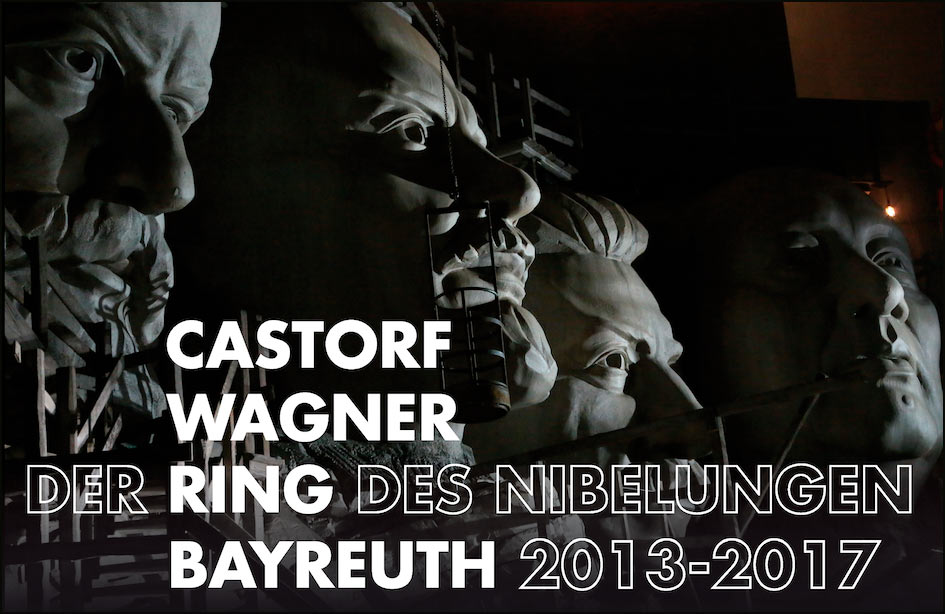
CASTORF / WAGNER Der Ring des Nibelungen 2013-2017: Bilingual book (french/german) about Frank Castorf's Ring production at Bayreuth edited by Guy Cherqui and David Verdier (Wanderer, Geneva)
Essays and Interviews Katharina Wagner (artistic director, Bayreuth), Frank Castorf (stage director), Aleksandar Denic (stage designer), Patric Seibert (assistant/actor), Adriana Braga Peretzki (costume designer), Wolfgang Koch (Wotan), Nadine Weissmann (Erda)...
Ring ABC
62 entries by Guy Cherqui and David Verdier
Specifics 26x17 cm 384 pages 200+ color plates, most of them exclusive photos
La Pommerie Éditions in collaboration with the Wanderer website ISBN 978-2-9564912-0-0 Info castorf.ringbook@wanderersite.com
More info here!
With essays by, and interviews of, the main architects of this project, this book aims for an in-depth analysis of the main lines of enquiry of a work that has already assured its place among the greatest Bayreuth productions. Frank Castorf’s theater has found in Wagner an ideological and polemic sounding board that echoes our most extreme issues of the day. The second part of the book is a lexicon of characters, themes and references that offers both readers and viewers points of orientation in the Castorfian Gesamtkunstwerk.


